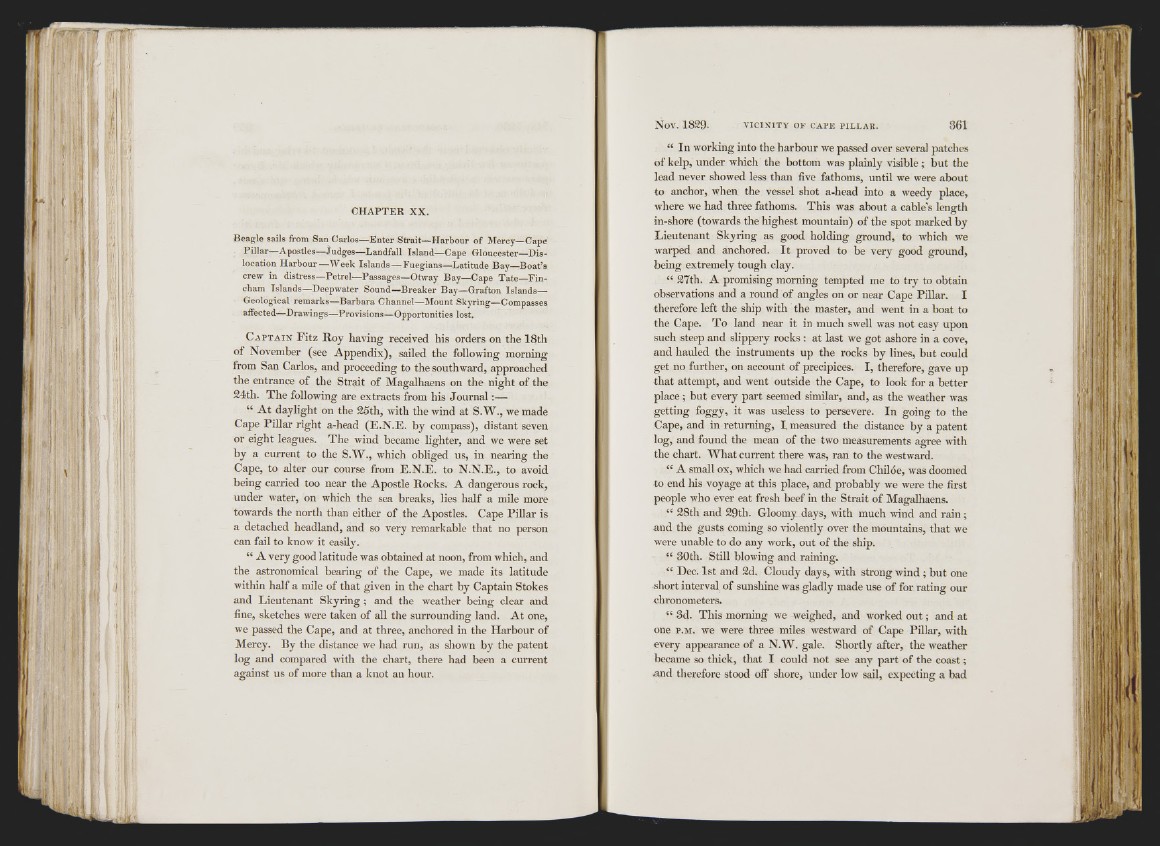
;
il '
í : i
C H A P T E R XX.
Beagle sails from San Gai-los—E n ter Strait—Harb o u r of Mercy—Cape
P illar—Apostles—judges—Landfall Island—Cape Gloucester—Dislocation
H a rb o u r—Week Islands — Fuegians—Latitude Bay—B oat’s
crew in distress—Pe tre l—Passages—Otway Bay—Cape Tate—F in cham
Islands—Deepwater Sound—B reaker Bay—Grafton Islands—
Geological remarks—B arbara Channel—Mount Skyring—Compasses
affected—Drawings—Provisions—Opportunities lost.
C aptain Fitz Roy having received his orders on the 18th
of November (see Appendix), sailed the following morning
from San Carlos, and proceeding to the southward, approached
the entrance of the Strait of Magalhaens on the night of the
24th. The following are extracts from his Journal:—
“ At daylight on the 25th, with the wind at S.W., we made
Cape Pillar right a-head (E.N.E. by compass), distant seven
or eight leagues. The wind became lighter, and we were set
by a current to the S.AV., which obliged us, in nearing the
Cape, to alter our course from E.N.E. to N.N.E., to avoid
being carried too near the Apostle Rocks. A dangerous rock,
under water, on which the sea breaks, lies half a mile more
towards the north than either of the Apostles. Cape Pillar is
a detached headland, and so very remarkable that no person
can fail to know it easily.
“ A very good latitude was obtained at noon, from which, and
the astronomical bearing of the Cape, we made its latitude
within half a mile of that given in the chart by Captain Stokes
and Lieutenant Skyring; and the weather being clear and
fine, sketches were taken of all the surrounding land. At one,
we passed the Cape, and at three, anchored in the Harbour of
Mercy. By the distance we had run, as sliown by the patent
log and compared with the chart, there had been a current
against us of more than a knot an hour.
“ In working into the harbour we passed over several patches
of kelp, under which the bottom was plainly visible; but the
lead never showed less than five fathoms, until we were about
to anchor, when the vessel shot a-head into a weedy place,
where we had three fathoms. This was about a cable's lenfOfth
in-shore (towards the highest mountain) of the spot marked by
Lieutenant Skyring as good holding ground, to which we
warped and anchored. It proved to be very good ground,
being extremely tough clay.
“ 27th. A promising morning tempted me to try to obtain
observations and a round of angles on or near Cape Pillar. I
therefore left the ship with the master, and went in a boat to
the Cape. To land near it in much swell was not easy upon
such steep and slippery rocks : at last we got ashore in a cove,
and hauled the instruments up the rocks by lines, but could
get no further, on account of precipices. I, therefore, gave up
that attempt, and went outside the Cape, to look for a better
place; but every part seemed similar, and, as the weather was
getting foggy, it was useless to persevere. In going to the
Cape, and in returning, I measured the distance by a patent
log, and found the mean of the two measurements agree with
the chart. AVhat current there was, ran to the westward.
“ A small ox, which we had carried from Chiloe, was doomed
to end his voyage at this place, and probably we were the first
people who ever eat fresh beef in the Strait of Magalhaens.
“ 28th and 29th. Gloomy days, with much wind and rain;
and the gusts coming so violently over the mountains, that we
were unable to do any work, out of the ship.
“ 30th. Still blowing and raining.
“ Dec. 1st and 2d. Cloudy days, with strong wind ; but one
Bhort interval of sunshine was gladly made use of for rating our
chronometers.
“ 3d. This morning we weighed, and worked ou t; and at
one P.M. we were three miles westward of Cape Pillar, ivith
every appearance of a N.AV. gale. Shortly after, the weather
became so thick, that I could not see any part of the coast;
and therefore stood oif shore, under low sail, expecting a bad
lb,111
i
Í
t I